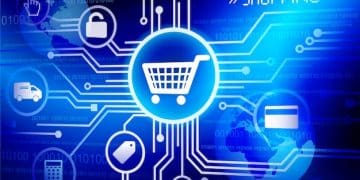E-commerce Marketing Trends: What’s New in 2025

E-commerce marketing trends in 2025 highlight personalization through AI, omnichannel experiences leveraging AR, and a focus on sustainable and ethical practices to meet evolving consumer demands.
The e-commerce landscape is constantly evolving, and staying ahead requires a keen understanding of emerging trends. In 2025, several key shifts are poised to reshape how businesses market and sell online. Mastering these e-commerce marketing trends will be crucial for success.
Understanding the Personalized E-commerce Experience
Personalization has been a buzzword for years, but in 2025, it’s no longer a luxury; it’s an expectation. Consumers crave experiences tailored to their individual needs and preferences.
AI-Powered Recommendations
Artificial intelligence is becoming even more sophisticated. AI algorithms analyze vast amounts of data to predict what customers want, offering hyper-personalized product recommendations and targeted marketing messages.
Dynamic Content Customization
Websites and apps are adapting in real-time based on user behavior. Dynamic content customization means that every visitor sees a unique version of your e-commerce platform, enhancing engagement and driving conversions.
- Data Privacy: Prioritize transparent data collection practices.
- Real-Time Adaptation: Implement systems that personalize content dynamically.
- Predictive Analytics: Leverage AI to anticipate customer needs.
Personalization in 2025 isn’t just about recommending products; it’s about creating a holistic, tailored shopping journey that resonates with each customer on a deeply personal level. It enhances customer loyalty and boosts sales.

The Rise of Omnichannel Shopping with AR/VR
Consumers now expect a seamless shopping experience across all channels, whether online, in-store, or on mobile devices. As we move towards 2025, augmented reality (AR) and virtual reality (VR) technologies are playing a pivotal role in bridging the gap between the physical and digital worlds.
Augmented Reality for Product Visualization
AR allows customers to visualize products in their own environment before making a purchase. This is especially useful for furniture, home decor, and clothing, reducing the uncertainty of online shopping.
Virtual Reality for Immersive Experiences
VR creates immersive shopping experiences that mimic the feel of browsing a physical store. Customers can explore virtual showrooms and interact with products in a realistic, engaging way.
- Cross-Channel Integration: Make sure your brand experience is consistent across all channels.
- AR/VR Investment: Explore AR and VR applications that enhance product visualization.
- Mobile Optimization: Ensure a seamless mobile shopping experience.
Omnichannel shopping, enhanced by AR/VR, provides customers with flexibility and convenience, leading to higher satisfaction and increased sales. It’s about meeting your customers where they are, providing a unified and engaging experience.
Sustainability and Ethical E-commerce Practices
Consumers are becoming increasingly conscious of the environmental and social impact of their purchases. In 2025, sustainability and ethical practices are not just nice-to-haves—they’re essential for building trust and loyalty.
Eco-Friendly Packaging
Sustainable packaging is gaining importance. Brands are shifting to eco-friendly materials, reducing waste, and promoting recycling to minimize their environmental footprint.
Ethical Sourcing and Production
Consumers want to know where products come from and how they’re made. Ethical sourcing and production practices ensure fair labor standards, safe working conditions, and environmentally responsible manufacturing.
- Transparency: Communicate sustainability efforts clearly to customers.
- Eco-Friendly Options: Offer sustainable product alternatives.
- Supply Chain Responsibility: Ensure ethical practices throughout your supply chain.
Prioritizing sustainability and ethical practices not only appeals to conscious consumers but also improves brand reputation and long-term viability. It’s a win-win for businesses and the planet.
The Influence of Social Commerce and Influencer Marketing
Social media platforms are evolving into powerful e-commerce engines. In 2025, social commerce and influencer marketing continue to drive sales and brand awareness.
Seamless Shopping on Social Media
Social commerce allows customers to make purchases directly within social media apps. This frictionless shopping experience reduces barriers to purchase and increases conversion rates.
Authentic Influencer Partnerships
Influencer marketing is shifting towards authentic partnerships. Consumers are more likely to trust influencers who genuinely align with a brand’s values and promote products they truly believe in.
- Platform Integration: Optimize your social media profiles for e-commerce.
- Influencer Selection: Partner with influencers who resonate with your target audience.
- Engaging Content: Create social media content that drives engagement and sales.
Social commerce and influencer marketing, when executed effectively, can significantly amplify brand reach and drive sales. It’s about leveraging the power of social networks to connect with customers on a more personal level.
Data Analytics and Privacy: Balancing Act
Data remains a crucial asset for e-commerce businesses, but with increasing privacy concerns, striking a balance between data utilization and customer privacy is paramount in 2025.
Advanced Analytics for Customer Insights
Advanced analytics tools provide deeper insights into customer behavior, preferences, and purchase patterns. These insights inform marketing strategies and product development.
Prioritizing Data Privacy and Security
Protecting customer data is non-negotiable. E-commerce businesses must adhere to strict data privacy regulations, implement robust security measures, and be transparent about data collection practices.
- Data Governance: Establish clear data governance policies.
- Security Measures: Implement robust security protocols to protect customer data.
- Transparency: Communicate your data collection practices clearly to customers.
Effectively balancing data analytics and privacy builds trust with customers while providing valuable insights to improve business operations.

The Future of Delivery and Logistics
Customer expectations for fast, reliable, and cost-effective delivery are higher than ever. In 2025, advancements in delivery and logistics are transforming the e-commerce landscape.
Drone Delivery and Autonomous Vehicles
Drone delivery and autonomous vehicles are becoming more prevalent, offering faster and more efficient last-mile delivery options, especially in urban areas.
Sustainable Logistics Practices
Eco-friendly delivery options, such as electric vehicles and optimized routing, are gaining traction as businesses seek to reduce their environmental impact.
- Delivery Optimization: Streamline your delivery processes for speed and efficiency.
- Technology Adoption: Explore innovative delivery technologies like drones and autonomous vehicles.
- Sustainability: Implement eco-friendly logistics practices.
The future of delivery and logistics focuses on speed, efficiency, and sustainability, providing customers with seamless and environmentally conscious shopping experiences.
Embracing New Payment Technologies
The way consumers pay for goods online continues to evolve. In 2025, embracing diverse and convenient payment technologies is crucial for capturing a wider customer base.
Cryptocurrency Payments
Accepting cryptocurrencies like Bitcoin and Ethereum can attract tech-savvy customers and provide an alternative payment method.
Buy Now, Pay Later (BNPL) Options
BNPL services are gaining popularity as they allow customers to split purchases into smaller, manageable installments, increasing affordability and driving sales.
- Payment Gateway Integration: Integrate multiple payment options seamlessly.
- Security Measures: Ensure secure payment processing to protect customer financial information.
- Mobile Optimization: Optimize payment processes for mobile devices.
By offering diverse payment options, e-commerce businesses can cater to a broader audience and enhance the overall shopping experience.
| Key Trend | Brief Description |
|---|---|
| 💡 Personalized Experiences | AI customizes user journeys, enhancing satisfaction. |
| 🛍️ Omnichannel Shopping | AR/VR bridge digital and physical retail. |
| 🌿 Sustainable Practices | Eco-friendly options build trust and loyalty. |
| 🚀 Social Commerce | Direct sales via social media increase conversions. |
FAQ
▼
The primary focus is on creating highly personalized shopping experiences through AI and data analytics, ensuring each customer feels uniquely valued and understood.
▼
AR allows customers to visualize products in their own space before buying, while VR offers immersive virtual store visits, bridging the gap between online and physical retail.
▼
Consumers increasingly prefer brands with sustainable and ethical practices. Prioritizing these values builds trust, enhances brand reputation, and supports long-term viability.
▼
Social commerce is becoming integral, enabling direct purchases within social media platforms, streamlining the shopping experience, and leveraging influencer partnerships for authentic brand promotion.
▼
Businesses must establish transparent data governance, implement robust security measures, and clearly communicate data collection practices to customers, fostering trust while leveraging data insights.
Conclusion
As we look to 2025, the future of e-commerce marketing lies in embracing personalization, leveraging innovative technologies, prioritizing sustainability, and fostering authentic connections with consumers. Staying informed and adaptable will be the key to thriving in this dynamic landscape.





